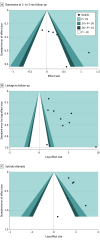Association of Suicide Prevention Interventions With Subsequent Suicide Attempts, Linkage to Follow-up Care, and Depression Symptoms for Acute Care Settings: A Systematic Review and Meta-analysis
- PMID: 32584936
- PMCID: PMC7301305
- DOI: 10.1001/jamapsychiatry.2020.1586
Association of Suicide Prevention Interventions With Subsequent Suicide Attempts, Linkage to Follow-up Care, and Depression Symptoms for Acute Care Settings: A Systematic Review and Meta-analysis
Abstract
Importance: To prevent suicide deaths, acute care settings need tools to ensure individuals at risk of suicide access mental health care and remain safe until they do so.
Objective: To examine the association of brief acute care suicide prevention interventions with patients' subsequent suicide attempts, linkage to follow-up care, and depression symptoms at follow-up.
Data sources: Ovid MEDLINE, Scopus, CINAHL, PsychINFO, Embase, and references of included studies using concepts of suicide, prevention, and clinical trial to identify relevant articles published January 2000 to May 2019.
Study selection: Studies describing clinical trials of single-encounter suicide prevention interventions were included. Two reviewers independently reviewed all articles to determine eligibility for study inclusion.
Data extraction and synthesis: Two reviewers independently abstracted data according to PRISMA guidelines and assessed studies' risk of bias using the Cochrane Risk of Bias tool. Data were pooled for each outcome using random-effects models. Small study effects including publication bias were assessed using Peter and Egger regression tests.
Main outcomes and measures: Three primary outcomes were examined: subsequent suicide attempts, linkage to follow-up care, and depression symptoms at follow-up. Suicide attempts and linkage to follow-up care were measured using validated patient self-report measures and medical record review; odds ratios and Hedges g standardized mean differences were pooled to estimate effect sizes. Depression symptoms were measured 2 to 3 months after the encounter using validated self-report measures, and pooled Hedges g standardized mean differences were used to estimate effect sizes.
Results: A total of 14 studies, representing outcomes for 4270 patients, were included. Pooled-effect estimates showed that brief suicide prevention interventions were associated with reduced subsequent suicide attempts (pooled odds ratio, 0.69; 95% CI, 0.53-0.89), increased linkage to follow-up (pooled odds ratio, 3.04; 95% CI, 1.79-5.17) but were not associated with reduced depression symptoms (Hedges g = 0.28 [95% CI, -0.02 to 0.59).
Conclusions and relevance: In this meta-analysis, breif suicide prevention interventions were associated with reduced subsequent suicide attempts. Suicide prevention interventions delivered in a single in-person encounter may be effective at reducing subsequent suicide attempts and ensuring that patients engage in follow-up mental health care.
Conflict of interest statement
Figures



Comment in
-
Do Brief Preventive Interventions for Patients at Suicide Risk Work?JAMA Psychiatry. 2020 Oct 1;77(10):997-999. doi: 10.1001/jamapsychiatry.2020.1287. JAMA Psychiatry. 2020. PMID: 32584942 Free PMC article.
-
Quality of Evidence of Individual Trials in Systematic Review of Brief Suicide Prevention Interventions.JAMA Psychiatry. 2020 Dec 1;77(12):1309. doi: 10.1001/jamapsychiatry.2020.3222. JAMA Psychiatry. 2020. PMID: 33052395 No abstract available.
-
Quality of Evidence of Individual Trials in Systematic Review of Brief Suicide Prevention Interventions-Reply.JAMA Psychiatry. 2020 Dec 1;77(12):1309-1310. doi: 10.1001/jamapsychiatry.2020.3228. JAMA Psychiatry. 2020. PMID: 33052396 Free PMC article. No abstract available.
References
-
- Curtin SC, Warner M, Hedegaard H Increase in Suicide in the United States, 1999-2014. NCHS Data Brief. Published April 2016. Accessed October 25, 2019. https://www.cdc.gov/nchs/data/databriefs/db241.pdf - PubMed

